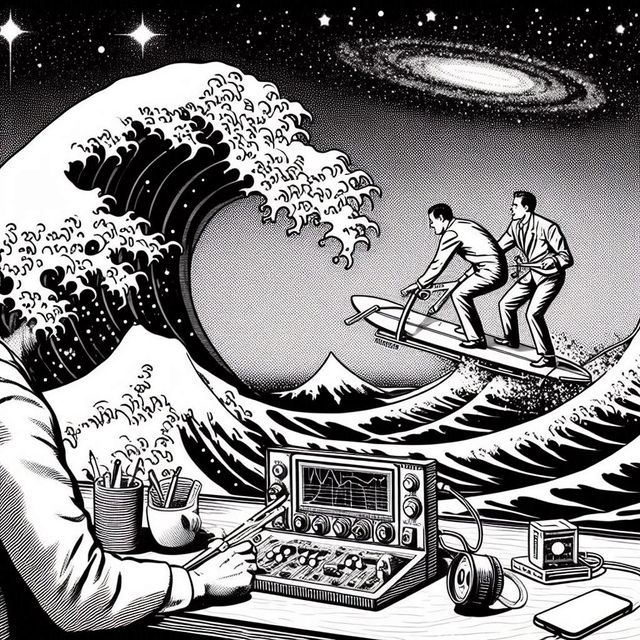-
Vijay Fafat
- Published on
A typical Rudy Rucker short story full of techno-jargon and hippie language.
Delbert and Zep are two brothers looking for good surfing opportunities. One day, Delbert hypnotizes Zep and plants an idea in his mind that Delbert is a great scientist capable of inventing a device for invisibility.
While invisibility does not appear (so to speak), Delbert does invent a “Chaos Attractor”, a device capable of mathematically simulating local conditions faster than actual reality and taking appropriate counter-action to reshape it, all within the laws of Physics. Initially, the device is built simply to analyze the local water waves and have a computer-assisted device manipulate them to create large waves. To make it efficient, it is also hooked into the surfer’s thought-patterns. Well… the gizmo turns out to do more than just outpace local chaotic conditions - it effectively magnifies the thoughts of the wearer and turns them into reality. By the end of it, the local nuclear plant has blown up and the surfers are surfing the Milky Way galaxy…
Rather pointless a story. But full of mathematical references related to computational methods and chaotic dynamics:
“Dig it, Del, I’m not going to say this twice. The ocean is a chaotic dynamical system with sensitive dependence on initial conditions. Macro info keeps being folded in while micro info keeps being excavated. In terms of the phase-space, it works by a kneading process, continually doubling the size of a region and folding it over on itself like saltwater taffy with the ribbony layers of color all shot through. Big waves disappear in the chop and the right small ripple can amp on up to make an outsider. If you do the right thing to the ocean, it’ll do whatever you want back. The thing about a chaotic system is that the slightest change in initial conditions produces a big effect—and I mean right away. Like on a pool table, dude, after ten bounces the position of the ball has been affected by the gravity from a pebble in a ring of Saturn. There’s a whole space of dynamic states, and the places where the system settles down are called chaotic attractors. We do right, and the ocean’ll do right by us.” Del was like: “Chaos attractor? How do we control it?” “There’s no formula because the computation is irreducibly complex. The only way to predict the ocean is to simulate it faster than real time. Could be done on a gigahertz CA. By the right head. The ocean…Delbert, the ocean’s state is a point in ten-trillion-dimensional surfspace.”
[…]
“You gotta relate, babe,” enunciated Zep, as he tore on into the rest of his riff. “The wave pattern at any time is a fractal. Waves upon waves upon waves. Like a mountain range, and an ant thinks he’s at the top of a hill, but he’s only at the top of a bump on rock on an outcrop on a peak on the range on the planet. And there’s a cracky crack between his six legs. For our present purposes, it’s probably enough to take ten levels of waves into account.”
“Ten levels of waves?”
“Sure man, like put your nose near the water and there’s shivers on the ripples. The shivers have got kind of sketchy foam on them too. So sketchy foam, shivers, ripples, wads, and slidy sheets, now we be getting some meat to carve, uh, actual waves, peaks—those choppy peaks that look like Mr. Frostee’s head, you wave—steamers and hollow surf, mongo mothers, outsiders and number ten the tide. So the wave pattern at any given spot is a ten-dimensional quality, and the wave patterns at a trillion different spots make a point in ten-trillion-dimensional surfspace.”
“What’s all the trillions for?” Out on the sea, Lex Loach and four other Stoke Pilgrims were riding in from the break. Loach, Mr. Scrote, Shrimp Chips, Squid Puppy, and Floathead, same as usual. They usually came up to the Pup-Tent for lunch. Delbert and Zep usually left before the Pilgrims got there. “Talk faster, Zep.”
“I’m telling you, dude. Say I’m interested in predicting or influencing the waves over the next few minutes. Waves don’t move all that fast, so anything that can influence the surf here in the next few minutes is going to depend on the surfspace values within a neighboring area of, say, one square kilometer. I’m only going to fine-grain down to the millimeter level, you wave, so we’re looking at, uh, one trillion sample points. Million squared. Don’t interrupt again, Delbert, or I won’t build you the chaotic attractor.”
[…]
Zep had scored the goods and spent the rest of the night wiring the CAM board into the imipolex-wrapped blank’s honeyheart with tiny wires connecting to the stick’s surface all over, and then finally at dawn Zep had gone in through the back window of a butcher shop and wedged the board into the huge vacuum meat packer there to vacuum-sputter the new stick’s finish up into as weird a fractal as a snowflake Koch curve or a rucked Sierpinski carpet.
“Why’s it so rough?”
Zep took a deep breath and concentrated on slowing down his heartbeat. Another breath. “This stick, Del, it uses its fractal surface for a realtime surfspace simulation. The board’s surface is a fractal CA model of the sea, you wave?”
